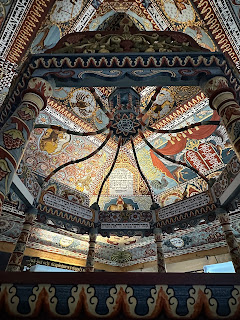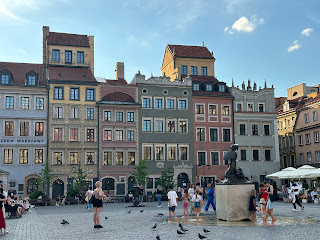Although my ancestors come from what are primarily shtetls or small Jewish communities, we are visiting the capital and large cities of each country, including Warsaw and Krakow. In fact, we organized our journey so that we would be in Krakow for the Jewish Cultural Festival. We made the journey from Marijampole to Warsaw arriving at our hotel, the Chopin Boutique Hotel in time to check in before exploring the downtown area for a late lunch of pierogies, one of Poland's national foods.
This evening we met our guide from Eat Polska for a food walking tour that began at a traditional Polish restaurant, Kamahda Lwowska. We started with appetizer of smalnec, or pig lard on bread with a pickle on top, and, of course, Polish vodka (Wyborowa). That was followed by a soup course of two different varieties -- Christmas borscht and a beef-based soup that didn't get eaten because the borscht was so delicious that I devoured it even though I thought I didn't like borscht. Christmas borscht is made from a fermented beet mixture which takes 5 - 10 days to make. A little lemon juice or vinegar adds some tartness. The dumplings, or uszka, are filled with mushroom and sauerkraut. Scrumptious!
Earlier in the day, after lunch, we stopped at a donut shop and shared one with salted caramel. Polish donuts, or paczki) do not have holes. They are a deep fried piece of dough that is shaped into a flattened ball and filled with rose jam or other sweets. A small amount of grain alcohol is added to the dough so that, as it evaporates it prevents it from getting too greasy. After frying they are topped with powdered sugar or a glaze. Our second stop was at a different paczki shop. Our guide bought us each a traditional donut filled with rose jam. Course three is a sweet, I suppose, based on the location of the dining stops. I devoured the paczki as fast as the Christmas soup.
The evening ended with a trip to the largest chocolatier in Poland -- Cafe E. Wedel -- for liquid chocolate. They melt their semi-sweet chocolate and add a bit of sugar, cream, and a little bit of vanilla. It was a celebration in my mouth and a perfect ending to a great night.
My experience in Latvia, Lithuania, and Poland has taught me that my knowledge of world history is basic and that the three countries had quite varied histories. Unlike Latvia and Lithuania, which were both incorporated into the Soviet Union after World War II, Poland was an independent satellite state with a government that was highly influenced by the Soviets. Most Latvians and Lithuanians were murdered in killing fields, shot and buried in mass graves. Most Jewish Poles were taken to concentration and death camps. The Jewish cemeteries in Latvia and Lithuania were completely destroyed by the Soviets. On the other hand, Polish cemeteries were damaged by the Nazis, but for the most part, they still exist in some form with many tombstones still intact, making a visit considerably different.
A little more family history is important to get a sense of my interest in Warsaw. As members of the Braufenbrener/Brofenbrener/Brenner (the three iterations of the surname) family started to emigrate in four stages -- first, my great grandfather; second, the oldest daughter Gittle (Gussie); third, the second daughter, Ruchel (Rose); and, finally, my great grandmother and the four youngest children, Chana (Hannah), Rechla (), Avram (Abraham), and Nashe (Mollie). The oldest brother, Mosze, was murdered before the family left. Their journey started with a train from Szczebrzeszyn to Warsaw where they stayed for a short time before catching a different train to Hamburg, Germany to board a ship to the United States. According to Mollie's birth records, she was born in Warsaw after her father had already left Poland.
Dr. Henry Goldszmit (Janusz Korcza) was a Jewish pediatrician and children's author in Poland as well as an advocate for children's rights. At the start of World War II he ran an orphanage for Jewish children, repeatedly refusing to leave them even when he was offered sanctuary. When the Nazis arrived at the orphanage in August 1942 to transport the children, around 192 at the time, to the Treblinka Concentration Camp, he led them out, each with a knapsack with a favorite book or toy. He and the children boarded the train. None survived. His story is mentioned in the book, The Pianist and is depicted in several movies including Uprising (2001) and The Zookeeper's Wife (2017). We visited the monument to Korczak in Swietokrzyski Park.
As we were walking I was surprised to see a kosher shop. There aren't many Jews left in Warsaw. The shopkeeper explained that the population has increased with the immigration of Ukrainian Jews as well as a growing, but small, group of Jewish Poles who still live in the city. We had to go in and buy something, so it was a perfect time for a little snack.
The Nozyk Synagogue, the only extant pre-war synagogue, is being renovated, and we had to take a circuitous route to find the entrance. It was built between 1898-1902 and first restored after World War II. The Nazis used the building as a stable and warehouse, thus, it served a purpose for them. I was in Warsaw for less than 24 hours in the mid-1990s, and, although we found the entrance then, it was late in the evening and the building was closed. On May 1 of this year the synagogue was struck by three firebombs, but there were no casualties and minimal damage, although it made me think about our safety. The incident was a result of the fermenting anti-Semitism about the war in Gaza, and it was quickly condemned by Polish authorities.
The exterior was impossible to photograph because it was covered for renovation, but the interior was remarkable. The building itself is neo-Romanticist and the interior has neo-Byzantine elements.
The Braufenbrener family came from the relatively small town of Szczebrzeszyn, a very difficult name for an American, especially me, to say. Further using the tongue-twister, Jan Brzechwa wrote a poem to make even the native Polish tie their tongues when he introduces the beetle (chrzascz) to the story. The poem is so popular that there is a statue of a beetle in town. That same author wrote a series of children's books which are illustrated in this mural based on one of his stories is close by to the synagogue.
The Old Jewish Cemetery in Warsaw was established in 1806 and cover 83 acres. It still is an active cemetery and most of the headstones are still extant, although many are impossible to see because they are either covered with ivy or warn away. Unlike the mass graves in Latvia and Lithuania, most of the victims of the Holocaust who perished in the ghetto have individual graves, although no tombstones. A few are noted with a small sign. but most have no markings.
Right before I left for our trip I saw the movie, Treasure, with Lena Dunham and Stephen Fry, about a Holocaust survivor from Lodz who travels to Poland with his daughter in 1991. The father, who is running from his experience but attempting to protect his daughter, stops in front of a random wall and claims it to be the remains of the Warsaw Ghetto. Of course, it is not. Our guide took us to the small remains of the wall that enclosed the Jewish ghetto and gave us a perspective of the location and size of the ghetto. At its height there were over 450,000 people living here within 1.3 square miles.
At the end of the tour our driver dropped us off at the Polin Museum of the History of Polish Jews which sits inside the site of the Warsaw Ghetto. The word polin in Hebrew means "rest here." According to legend, the Jews heard these words as they entered the land of Miesko. When the Jewish people settled here it was covered with thick woodland. As we entered the museum we were met by three screens of trees placed as the start of Jewish history in Poland.
We had three and a half hours in the museum, and that was not enough time. As you make your way through the exhibits the museum moves through time. When the announcement came for the museum's closing we had just passed World War II. I quickly moved through the Holocaust since that has been so well documented and found myself surprised by the continuing violence against Jews, including an expulsion from the country in 1968 during the time of Soviet influence when Jews were blamed for the killing of a Polish man. The propaganda against Jews after the murder was shocking. I was 14 years old and have no memory or knowledge of the continuing anti-Semitism. It wasn't until the fall of the Soviet Union that the situation in Poland began to change, albeit it very slowly. Today the Polin Museum stands in testimony of the country's attempt to educate not only the Poles, but also the world.
The highlight of my visit to the museum was the full-size reconstruction of the bimah and roof of the Gwozdiecz Synagogue, one of the hundreds of wooden synagogues that were destroyed by the Nazis. I had watched the documentary about its building, Raise the Roof, a couple of times and witnessed the project that included professionals and students in the building and painting of the structure. As I marveled at the colorful structure, I FaceTimed Ari to share the experience with him.
Our guided tours have focused on Jewish history, and we wanted to get a sense of the city itself, a vibrant place with lots of restaurants, bars, music, squares, fountains, and people. We also had tickets for a Chopin piano concert at 6:30 and dinner reservations at an upscale Polish restaurant, Delicja Polska, so without any time to go back to the hotel, we headed to Old Town for a delightful evening.











































Fran, I loved your blog and your ability to trace your family history. Excellent writing and photographs. What a wonderful experience.
ReplyDelete